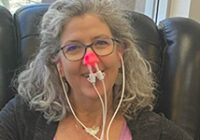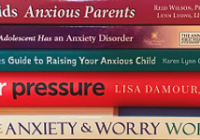by Aviva Romm, MD, avivaromm.com
One recent afternoon a lovely natural momma in my neighborhood wrote me a semi-frantic email. Her little 9-month-old daughter was running “a high fever,” of 100.4 she said. Since her daughter also had a cough, she was worried about pneumonia. “I’ve been giving her ibuprofen ATC to try to bring the fever down and I’m really scared….” A few emails later she was reassured that this was a low temp, did not meet the symptoms of pneumonia, and she was able to relax.
So what if your little one wakes up in the middle of the night, fretful and hot to the touch. You check her temperature and it is 102 degrees. She’s had a cold for a few days but hasn’t had a fever until now. You feel worried and don’t know what to do. Should you give Tylenol, go to the emergency department? Should you call your doctor’s office hoping to reach someone in the middle of the night? Can you wait until morning? You’ve heard about using herbs for fever and thought it sounded good at the time, but now that your child has one, you’re not so sure, it’s better to put on a song for your baby and check so you have piece of mind.
What should you do?
The answer to the above question for starters is:
- If your child is under 1 month old and has a temperature of over 100.4 degrees, or under 3 months old with a fever over 101.5 and nobody else in the family has a cold, call your doctor or go to the emergency room.
- For everyone else, take a deep breath, relax, and read on…
Fear of Fever
I get it. When my son was round 18 months old he had his first fever…. The doctor I took him to suggested rubbing alcohol rub, Tylenol, and an antibiotic. Intuition told me not to do these things, but I was also scared. We’ve all been pretty well programmed to assume we have to treat fever, and even that it’s scary or dangerous. Thankfully, I didn’t give the unnecessary antibiotic and chose not to do the alcohol rub, a now outdated practice because we’ve learned that it’s terribly dangerous, and I used herbal remedies instead of the Tylenol.
But I wanted to learn more so that I felt more confident next time. If you’re a parent, you’re inevitably going to deal with or face a fever because pretty every otherwise healthy child is going to have one at some point.
So I set out to to understand more about fever, get comfortable with it, know when to get medical care – and when not to – and what to do to make my child more comfortable. That was 30 years ago, and I’ve now guided 10’s of 1000’s of families safely through fevers without unnecessary medical treatments.
Fever is at the top of the list of 3 symptoms or conditions parents are most afraid of (cough and meningitis are the two others). In fact, over 5 million parents take their kids to the emergency department each year for fever. Brain damage, coma, and death are the consequences parents fear if fever isn’t treated. Actually, some health care providers are also afraid of this. But the facts are that those fears are very unrealistic in almost every case of fever in a child. Nonetheless, it can feel really darn scary when our kids are sick. We’ve been raised to think that fevers are dangerous, and this is reinforced by the fact that we’re encouraged by our children’s doctors to give medication to bring the fever down. But is this really necessary? And are fevers dangerous?
What is a Fever? Is it Dangerous?
Most importantly: Fever is not an illness. It is the body’s healthy, natural response that helps fight infection! So they are actually a good thing! A temperature over 100.4 degrees F is considered a fever. Most fevers are in the range of 101-103.5 degrees. A high fever is over 103.5. The body raises the temperature to create an inhospitable environment for most of the “bugs” that can make our kids sick, and which prefer to thrive at normal body temperature. A fever is also part of a natural and healthy inflammatory response that mobilizes white blood cells, antibodies, and cytokines to fight infection.
Fevers in kids are generally caused by common viral infections, and most of these are not dangerous. Kids will often have symptoms such as a cough, runny nose, earache, or rash – but often the fever comes before the symptoms. When there are cold symptoms accompanying a fever, all you pretty much need to do is wait it out, keep your child comfortable, and keep him hydrated. Interestingly, even more kids with ear infections and sore throats (85% of sore throats are viral, not strep) do not need medical treatment other than also comfort, support, and hydration. Bacterial infections such as strep throat, urinary tract, and some ear infections can also cause fever and these are reasonable times to treat with pain relieving medications if symptoms are severe and not responsive to natural therapies, and with an antibiotic (see below, When to See Your Doctor). However, if you are suffering from something like an urinary tract then it would be a good idea to seek medical help. They might use something like a cystoscopy to help treat you, but it will be worth getting it done if you are struggling.
Of note, the height of a fever has very little relationship to the severity of the illness, except for in babies under 3 months; in that case, the risk of a serious illness is 10 times higher with a high fever. Kids can have more serious illnesses with lower temperatures, and have common upper respiratory viral infections with a high fever.
But what about brain damage from fever? The idea that there is a “glass ceiling” on fever has been recognized since the 1940s. Unlike in a condition like hyperthermia, which can occur with certain medications or nervous system problems where the body’s thermostat has been hijacked, in fever the brain has a natural turn-off mechanism. Fevers in kids rarely EVER exceed the body’s natural fever cut-off point above which it’s not going to go higher than is safe. Brain damage from a fever is so extremely rare and it’s just really not something to worry about in otherwise normal kids. In fact, there is nothing inherently dangerous about fever. The risk really has to do with what the underlying infection is.
Are Fever Medications Okay to Give?
While Tylenol, ibuprofen, and similar medications can reduce fever by about a degree, they don’t get to the underlying cause, don’t shorten the duration of the illness, and while they can help your child to be more comfortable, which is important, they do carry risks. Tylenol has been associated with liver toxicity and increases the risk of developing asthma. Ibuprofen, and other NSAIDs, can cause gastritis and stomach bleeding just from using them every day for a week for fever, are associated with secondary infections, and may delay healing.
In my practice, unless a child is extremely uncomfortable, for example with the flu, and natural remedies aren’t touching the symptoms, I recommend a day or so of using the common fever medications, but I do always recommend natural remedies first because they are often a safer choice. However, with more severe discomfort, the simple common herbs aren’t always enough, and professional guidance from an integrative doctor might be needed.
Febrile Seizures
I just want to mention a word about seizures, because if your child experiences them, it can be downright terrifying to see, and it’s a good idea to know about them.
About 4% of all children will sometimes have a seizure with their fever. A febrile seizure is caused by rapid increase in the temperature, not by the height of the temperature. They typically occur between 6 months old and 5 years old and they rarely ever have any lasting consequences, and they rarely ever predict that that child has a seizure disorder like epilepsy. Once a child has already had a high fever and a febrile seizure, a seizure is unlikely to recur again in that illness, but that child is likely to have seizures with subsequent fevers.
If your child does have a seizure, it’s very scary. A lot of parents will call 911. It’s not technically necessary to do so, but no harm if you do, of course, and you might feel you need that support – totally understandable. Call your pediatrician or Family Doctor and let them know what’s happened and find out what they want you to do, and discuss your plan of action for next time so you’re prepared should it happen again. Of note, the use of fever-reducing medications has not been shown to prevent febrile seizures.
When to See the Doctor
Most fevers are due to minor and self-limiting viral infections. The exception to that is if a child has a fever and doesn’t really have any cold symptoms. One thing to consider in that case is a urinary tract infection, so you want to be aware of that.
Any babies under 3 months old with a fever should be seen by a physician because they’re more susceptible to serious bacterial infections just due to the natural immaturity of their immune system, and also higher risk of infections that they could have picked up if they were born in the hospital or if mom had any kind of communicable vaginal infection.
Any babies under 6 months old with a high fever – remember, that’s over 103.5 degrees – and any child with a fever of over 104 should be seen, unless the fever comes down quickly, with fever treatments like Tylenol or ibuprofen, and the child is otherwise comfortable. Any kids who are not taking fluids or not urinating a normal amount or just not acting right should be seen. If there’s a stiff neck, persistent vomiting or severe headache – which can be meningitis, although again, that’s rare – severe ear pain or belly pain, they should be seen. If they don’t seem fully able to wake up, they seem weak or limp or they can’t make eye contact. And children of any age who have had recurrent fevers for more than 7 days, even if the fever lasts only a few hours. And, of course, if you just feel like your child needs to be seen, then go get seen.
Now, for me, as a mom, I usually started to get a little anxious when the fever got over 104. And that’s my experience with a lot of parents. Once it starts climbing over 104, 104.2, parents get pretty nervous. That’s a good time to call your pediatrician or family doctor, if you haven’t already, and that’s the point where I usually say, “You know what? If you want to give something to bring the fever down a little bit, that’s reasonable.” Because it just puts you back in your own comfort zone.
In summary, see the doctor for:
- All babies under 1 month old with fever should be seen by a doctor immediately. This can be a medical emergency!
- Babies under 3 months old with a high fever (see above) should be seen by a doctor.
- Any kids who are not taking fluids, not urinating a normal amount compared to usual, or are just not “acting right” should be seen by the doctor.
- Any kids with fever along with stiff neck, persistent vomiting, or severe headache should be seen by the doctor.
- If your child has severe ear pain or severe belly pain.
- If your child is lethargic – that is, he just isn’t really waking up fully, seems weak, or just seems sort of limp, is just lying there, and doesn’t really make eye contact.
- Fevers that stay high for more than 3-5 days.
- If you feel worried that your child has a serious illness, take your child to the doctor. Remember, trust your momma intuition! (and better safe than sorry).
Remember, though, most times a fever is just a helpful way your body has to fight a viral infection. Supportive care with fluids, rest, and light foods, and the comfort of herbal teas and extracts, is generally all that’s needed to help your children recover safely and naturally.
What Can You Do?
Keep in mind that you do not have to treat the fever itself – the body is trying to mount this fever to fight the infection.
When your child has a fever the most important thing is to encourage rest and give plenty of fluids. Fevers may continue for a number of days or go away and come back – especially in the afternoon and evening – for several days. This is usually not a problem if the child is taking plenty of fluids and seems otherwise well.
- Hydration is key: Give your child loads of fluids during the fever. Nursing babies should nurse freely. Older babies can be nursed often and given a little bit of water by teaspoon, sippy cup, or even an eye-dropper every 30 minutes. If your child is sleeping a lot, wake him up periodically for sips of water or tea. If your child is refusing to drink much, then give herbal or natural fruit juice ice pops. While I’m not a fan of giving sugary fruit drinks, getting fluids in is essential – and an average ice-pop has about 4 oz. of fluids and kids love them.! Herbal ice pops are also a terrific, tasty and sneaky way to get natural remedies into your kiddo! See the opt-in option at the end of this article for a wonderful herbal ice-pop recipe download!
- Let your child rest and sleep as much as she needs to. Create a quiet, comfortable, restful environment and keep your child home from day care or school during a fever.
- It’s normal for kids to have very little appetite when feverish. Keep foods light – soups, broths, toast, small amounts of fruit, steamed vegetables – and don’t force them to eat. But do push fluids!
Herbal Treatments
Herbs can be used to help ease the symptoms associated with a fever – aches, headache, tummy discomforts, and chills. High fevers can be lowered a bit with these herbs. Here are some classic herbs for feverish kids that I used with my own children and that I use in my medical practice. These are also safe for babies.
Catnip, chamomile, and lemon balm tea are relaxing, and for a high fever, they do actually bring it down just a little bit. They soothe tummy aches and general body aches. They also calm the tummy which is sometimes upset with fever, and they help with mild headache. The also generally promote relaxation and sleep, quiet indigestion that can accompany a fever or an upper respiratory infection. Ginger tea is antiviral, antibacterial, is great for tummy troubles, and it relieves aches and pains at a level equal to ibuprofen, but without the risk of side effects.
You can also use these herbs in glycerites and tinctures for a stronger effect, and valerian can be given safely even to babies over 6 months, to help with sleep. Herb Pharm and Gaia Herbs are both companies that put baby and child dosing on their packaging to make it easier for you.
If there are signs of cold or cough, you can also add in age-appropriate doses of immune boosting supplements like vitamin D, zinc, and vitamin C, as well as a probiotic for 5-10 days.
Herbal Teas
Tea is usually given in a dose of 1-2 eye droppersful to 1/4 cup to children under 1, 1/4-1 cup every few hours to toddlers and older children. For children over 1, teas can be sweetened with honey or maple syrup. Honey is excellent for treating coughs, too! (Do NOT give honey to babies under 1 year old – it can cause infant botulism.)
- Chamomile, Catnip, and Lemon balm tea: To prepare, mix equal parts of the dried herbs and prepare according to the tea instructions below. This is very pleasant tasting and very gentle even for little babies. It soothes a tummy upset, aches, and eases fever symptoms.
- Fresh ginger root tea can quiet indigestion. Grate 1 tsp. of fresh ginger root and prepare as with other teas. Ginger tea can help fight upper respiratory infection and help sweat out a fever.
- Spearmint leaf and Elder blossom tea: This is a slightly stronger tea. Steep 4 TBS. of each herb together in a covered quart jar of boiling water for 20 minutes. Strain and sweeten lightly. It’s especially helpful for bring the fever down a little bit by causing a sweat, which you can do if you’re feeling nervous, but remember, causing a child to sweat actually leads to more loss of fluids and risk of dehydration, so bump up the liquids.
If you can’t find these herbs locally, they can be ordered from the online company Mountain Rose Herbs. Nursing moms with feverish nursing babies can drink adult doses of these herbal remedies. Some of the benefits of the herbs will pass through the milk to the baby, but not a ton – baby can be given unsweetened herbal tea via eye dropper next to the nipple, but honestly, breastfeeding itself does the job, so that’s what I encourage.
Herbal Extracts
My favorite herbal extracts for soothing fever symptoms are Children’s Herbal Compound by Herb Pharm which contains Lemon Balm, Chamomile, Catnip, and Fennel, and Calm Child, a wonderfully soothing and calming blend by Planetary Herbals. Kids Sleep and Relax Herbal Formula from Gaia Herbs is also fantastic for helping them to do exactly that! Dose as directed on the various products. These can be combined or alternated with the teas.
Additionally, a few drops of Lavender essential oil can be added to a warm bath, 5 drops per bath, to soothe fever symptoms, but overall, baths shouldn’t really be used to cool kids down; they just get a chill when they come out. But they can be used for relaxation.
CBD oil can help to deal with the pain associated with fevers. Studies have shown that CBD may help reduce pain by impacting endocannabinoid receptor activity and reducing inflammation. It is fairly easy to buy it as there are many different companies who sell their own brands, but just make sure you are ordering the right stuff. If you are looking for CBD oil UK, then follow the link for some handy reviews.

How To Know That Things Are Improving
Kids can run fevers for 5-7 days. Things are improving when your child is starting to perk up and feel better. Sometimes, you’ll notice they’ve broken a sweat. Your child starts to want to get up, play more and interact, and their appetite is returning.
I usually recommend staying on the supplements for about 5 days or so after the fever has broken to continue to boost the immune system.
In summary, remember, most fevers are viral infections; in babyies under 3 months a visit to the doctor is critical; it may also be necessary in babies under 6 months old. Keeping your child comfie, offer a light diet guided by your child’s appetite, lots of hydration, use simple herbal teas instead of potentially harmful medications, and if meds are needed, a few doses only, over a few days maximum.
And remember, to get my herbal ice pop recipe below!
Wishing you trust in your momma wisdom!
– Aviva
P.S. If you want to hear my podcast, Who’s Afraid of Fever in Kids, don’t miss it! You can access it right here. And if you want to take a deep dive into getting confident taking care of your child naturally, at home, check out my course Healthy All Year, and join over a 1000 moms learning to be the Health CEO for their own family.
This article was used with permission from Dr. Aviva Romm of avivaromm.com.












